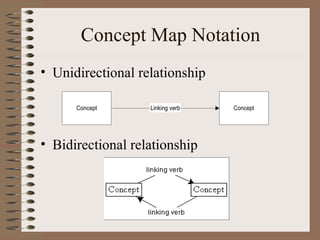Concept mapping tutorial
- 1. Concept Mapping Tutorial
- 2. What Is a Concept Map? Like all maps, concept maps are representations of spatial relationships. Rather than portraying the physical structure of space, concept maps reflect the psychological structure of an individual’s knowledge.
- 3. The Structure of Knowledge Theoretically, knowledge is structured as a semantic network (Collins & Quillian, 1969). Thus, learning is not only the acquisition of new concepts but the construction of meaningful links among concepts (Ausubel, 1968). Concept maps show what individuals know and how their knowledge is structured.
- 4. All Maps Have 3 Components Nodes represent concepts. Lines represent relations between concepts, arrowheads indicate direction. Labels on the lines describe the nature of the relationship. Combined, these three components create propositions or meaningful statements.
- 5. Map structures can differ • Because concepts are perceived regularities in events or objects, individuals can have different conceptual understandings of the same topic. • Thus, concept maps can be intrinsically different without being “wrong.” • The next two slides present two ways of structuring concept maps. They also provide more information about concept mapping.
- 8. Beginning Your Concept Map Think about the focus question you have been given and identify 10 to 20 (or as requested) of the most pertinent concepts (single words or three words at most). List these concepts on a piece of paper, and then write each one on a separate post- it note.
- 9. Two Options for Arranging Concepts • You can structure your map hierarchically by placing the most inclusive, most general concept(s) at the top and less important concepts at the bottom (see Figure 1). • You may also create a non-hierarchical network. In this case, there is no superordinate concept; the map is structured like a web (see Figure 2).
- 10. Creating Propositions • Draw your array of post-it notes on a piece of paper. • Think about which concepts are related. Connect related concepts with lines. • Label the lines with one or a few linking words. Linking words should define the relationship between the two concepts. For example, “involves” and “such as” are linking words. Each pair of linked concepts should read like a sentence.
- 11. Indicating the Direction of the Relationship Add arrowheads to the lines between the concepts to indicate the direction of the relationship. Depending on the nature of the concepts’ relationship, lines can have single or double arrowheads. Causal relationships are one-directional. Mutually influential relationships require double-headed arrows.
- 12. Concept Map Notation • Unidirectional relationship Concept Linking verb Concept • Bidirectional relationship
- 13. Reflect on Your Map Think about your concept map. Do the propositions you’ve created make sense? Is there a better way to present your concepts? If so, feel free to move your concepts around, adding or deleting concepts or links.
- 14. An Alternative Way to Create Concept Maps A tool for creating concept maps electronically is available for free download at http://cmap.coginst.uwf.edu/. On this web site you will also see a fairly extensive tutorial to help you get started with the program.
- 15. How to Enable Arrowheads
- 16. Getting Your Map to Us • We will accept maps hand drawn on a single sheet of paper. • We would prefer that the maps be done with the cmap tools program that is downloadable. • Maps may also be done with tools such as Microsoft Visio, but are not as easily manipulated.
Editor's Notes
- Author: Bear Sunderland Editors: Paul King and Joan Walker This is joan’s edit of bear’s original tutorial.
- Grounded in a constructivist perspective of learning, concept maps have 3 elements: nodes or concepts, lines representing links and directional relations among concepts, and labels that describe the nature of the relationship. These 3 elements combine to create propositions , or meaningful statements. Such as “concept maps represent organized knowledge.” and “concepts are perceived regularities.”
- This map is hierarchically structured. The superordinate concept “Concept maps” is followed by tiers of increasingly subordinate concepts and examples.
- Example of how a non-hierarchical concept map can be constructed. No superordinate concept, but an interrelated network of ideas.
- You begin by generating a list of the most important ideas on a sheet of paper. Then you write each concept down on separate sticky-notes and begin arranging them in a manner that makes the most sense to you. Sticky-notes are useful since they can be moved around as you determine better relationships between concepts.
- Refer to the examples of hierarchical and non-hierarchical maps presented in previous slides for examples of map structures.
- After you have arranged the concepts, transcribe the concepts onto a single sheet of paper and link them together. It is important to label the lines between concepts. Without this information, it is impossible to understand how the concepts are related.
- If you’ve chosen to create your map electronically, it’s important to know how to display arrowheads.
















